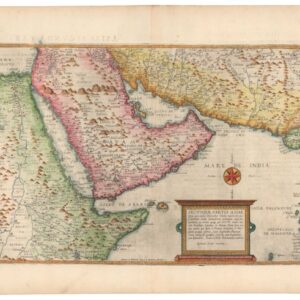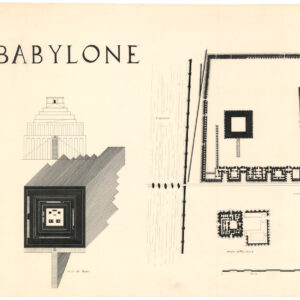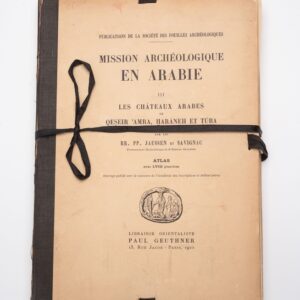No Copies Traced — an 1889 Colton Co. topographical wall map of Jerusalem, printed on silk.
Topographical Map of Jerusalem from the Ordnance Survey.
$8,500
1 in stock
Description
This is an extraordinary and exceedingly rare 1889 chromolithographed map of Jerusalem—printed on silk and adapted from Captain Charles Wilson’s pioneering 1864–65 Ordnance Survey of Jerusalem. Measuring an impressive 42 by 58 inches, the map was presumably created for late-nineteenth-century missionary use but survives as if it never traveled.
Just like Wilson’s original, the Colton map presents a detailed plan of Jerusalem and its immediate environs. It delineates the city walls, gates, and streets, and differentiates the four traditional quarters (i.e. Armenian, Christian, Jewish, and Muslim). Black contour lines show elevation, each representing ten feet, and wrapping around Jerusalem’s hilltops. While the regular lines are in black, every fifth line, or fifty feet, is marked in red and includes an exact elevation above the Mediterranean. A similar chromatic distinction is found in the place names, which, when of Biblical or ancient origin, are in red, and otherwise are in black.
A range of important sites is carefully marked on the map. These include iconic historical landmarks such as the Western (Wailing) Wall, the Holy Sepulcher, the Haram al-Sharif (Temple Mount), the Dome of the Rock, the Muristan (a hospital founded by the Hospitaller Knights of St. John during the Crusades), and the Ottoman Citadel. The map also shows more modern facilities, such as the Russian, Greek, and Austrian hospitals, which were often of particular interest to foreign pilgrims and visitors.
Throughout the map, cisterns, wells, and other hydrological installations receive nearly as much attention as the landmarks, reflecting the original survey’s focus on the city’s freshwater supply (for more on the original survey, see the Context section below). Large urban reservoirs have even been highlighted bright blue. In scope, the map also shows the contoured countryside just beyond the city walls. In addition to the large Russian compound in the upper left corner, the extra-muros landscape also features distinct cemeteries for the three faiths.
At the bottom of the map, two cross-sections show the city’s topography in profile (from west to east and north to south, respectively).
Census
This silk Jerusalem plan is unrecorded in public collections.
The overt scarcity of this map, combined with the unusual silk medium, makes this 1889 Colton map of Jerusalem a unique opportunity for collectors and institutions focused on Palestine/the Holy Land, or urban cartography.
Context is Everything
The present map was based directly on the official British Ordnance Survey of Jerusalem (October 1864–June 1865). This was a focused, nine-month field project led by Capt. Charles W. Wilson was executed by a small team of Royal Engineers. It was the first formal British Ordnance Survey carried out beyond the United Kingdom, and is widely regarded as the first scientific mapping of Ottoman Jerusalem and its immediate environs.
The project originated as a privately sponsored initiative to establish a reliable water supply for a city that was attracting an increasing number of European pilgrims, settlers, and travelers. Initiated through a cooperative fundraising campaign, the Water Relief Fund brought together Lord Shaftesbury, Angela Burdett-Coutts, Alexander McCaul of the London Jews’ Society, and James Finn (former British consul in Jerusalem) to underwrite the expedition. Wilson, then twenty-eight years old, commanded a team of six Royal Engineers.
Although locating new potable water sources was the survey’s ostensible objective, the fieldwork yielded much broader scientific and strategic returns. The engineers did not identify significant new springs suitable for the city’s needs, but their measurements and detailed plans established new standards of accuracy in urban cartography.
Contemporary observers hailed Wilson’s plan as “the first perfectly accurate map” of Jerusalem, and subsequent commentators have described it as serving “as the basis for all future research of the Holy City.” The survey combined topographic precision with local knowledge-gathering. Wilson collaborated with Carl Sandreczki of the Church Mission Society to record place names in Arabic, thereby strengthening both the linguistic and cartographic records.
Field investigations extended beyond surface features. The team was granted access to subterranean structures beneath the Haram al-Sharif (Temple Mount), and their work disclosed features of significant architectural and historical significance. The most notable was a medieval arch springing high above the Wailing Wall, which had once carried a bridge that connected the Temple Mount to the Upper City on the western hill. To this day, this ancient feature is known as Wilson’s Arch. The survey also produced the first rigorous determinations relating Mediterranean sea level to the Dead Sea depression, a crucial geodetic benchmark for subsequent exploration.
The 1864–65 survey provided the immediate practical impetus for founding the Palestine Exploration Fund in 1865. Wilson’s leadership of the survey made him a natural choice to direct this new organization. Taken together, Wilson’s field methods, his attention to local toponymy, and the technical quality of the resulting map mark the Ordnance Survey as a turning point in the modern study of Jerusalem.
Cartographer(s):
The Colton Mapmaking Company was a prominent family firm of cartographic printers, who in the nineteenth century were leaders in the American map trade. Its founder, Joseph Hutchins Colton (1800-1893), was a Massachusetts native who in 1830 moved to New York City and slowly began setting up his publishing business, which in the beginning drew heavily on licensing maps by established engravers such as David H. Burr, Samuel Stiles & Company, and later Stiles, Sherman & Smith. Smith was a charter member of the American Geographical and Statistical Society, as was John Disturnell. This connection would later benefit Colton, in that it helped him to acquire the rights to several important maps.
By the 1840s, the Colton firm were producing their own maps. They produced anything the markets desired, from massive and impressive wall-maps to pockets guides, folding maps, immigrant guides, and atlases. One of the things that set the Colton company aside from many of its contemporaries in terms of quality, was the insistence that only steel plate engravings be used for Colton maps. These created much more well-defined print lines, allowing even minute features and labels to stand out clearly. By 1850, the Colton firm was one of the primary publishers of guidebooks, immigration itineraries, and railroad maps in America.
In the 1850s, Colton’s two sons, George Woolworth and Charles B., were brought on board to the firm. This inaugurated a process of expansion in which the company began taking international commissions and producing wholly independent maps and charts. From 1850 to the early 1890s, they also published several school atlases and pocket maps. The firm continued until the late 1890s, when it merged with a competitor and then ceased to trade under the name Colton.
Condition Description
Highly-detailed oversize plan of Jerusalem lithographed on two large panels of silk cloth sewn together, with colors printed and finished by hand. Wide margins with hemmed upper edge; minor staining.
References
![[Old Damascus]](https://neatlinemaps.com/wp-content/uploads/2019/09/NL-00657-scaled-300x300.jpg)
![[Old Damascus]](https://neatlinemaps.com/wp-content/uploads/2019/09/NL-00657-scaled.jpg)


